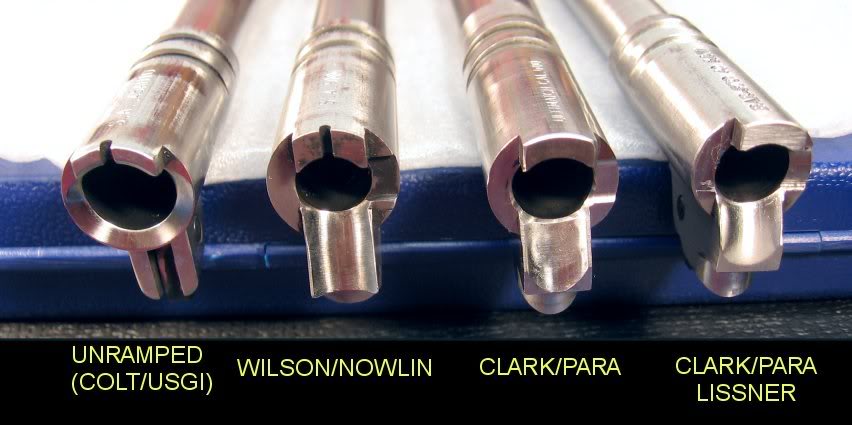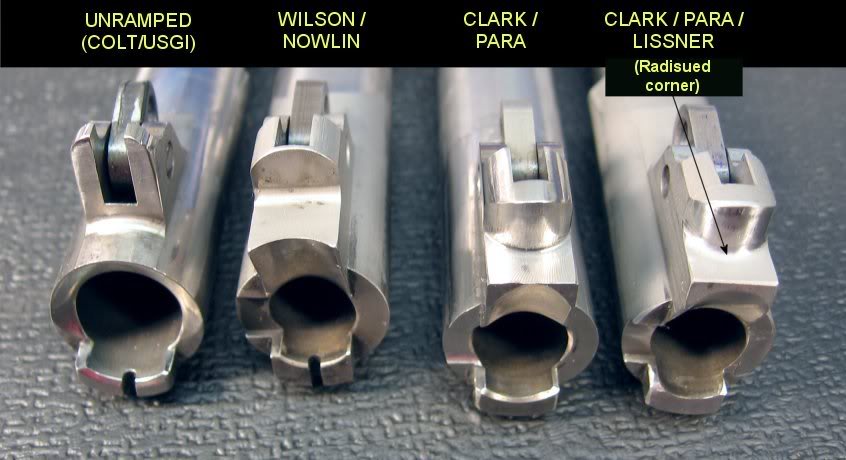
The Brownells Catalog lists 1911 barrels with ramps in both the "Wilson/Nowlin" and "Clark/Para" configuration. What's the difference, which do you consider best and why? Also, which one does Caspian normally provide in their ramp-cut frames?
The only ramped cut I ever had done was a Clark/Para. I do have a Springfield gun that came with a Wilson/Nowlin cut though. The Clark/Para is a whole lot simpler to machine than the Wilson. You can do it with a standard sized end mill (don't remember exactly but it is the same width as a bottom set of barrel lugs) with the frame rails set up horizontal. With the Wilson cut you have to stand the frame up and use a big old long tool that cost about 90 bucks.
Also if you ever go to to Schueman's barrel web site http://www.schuemann.com/ and read, somewhere on there he has or at least he used to have a statistical breakdown of which barrels came back broken or sheared more than the other. His Clark/Para style barrels had fewer failures than the his Wilson/Nowlin type barrels. This was why I decided to use the Clark style cut on a gun I did. When you look at the two different cuts side by side you have to wonder why Wilson and Nowlin even bother to continue making them this way. It's not efficient, but then that is just my opinion.



I too am trying to decide on ramped vs not in my .45 build. I have read that there is no reason for a ramp on a 45 for FMJ but since the frame is cast for one is there a downside to having a ramp on a 45 that is mainly going to shoot 45 FMJ hardball?
One thing for sure is the ramped are significantly more expense. The other alternative would be to machine a plug for the slot. I ran across a site talking about such for reviving aluminum frames. The piece is held by a set screw under the slide stop.
I filled mine up with weld, machined as normal, works fine.
t's harder to find a cheap ramped barrel, but the ramp doesn't add anything to a premium barrels price.
The advantages of the ramped barrels are improved case head support and a much stronger lower lug. The lower lug thing becomes more important as the barrel gets heavier, like when compensators are added. You can also reduce that pesky back of the slide to frame alignment issue to the extent disconnector timing allows without worrying about making the lower lug too thin.
The disadvantages are bargin barrels are harder to find and the guns timing becomes more important because the round hits the barrel and starts pushing it forward as soon as it comes out of the magazine instead of dragging along the frame for awhile. Three point jams are much easier to make happen. Know, love, and live the Schuemman timing tests.
The machine work for the Clark/Para ramp is either a problem or a feature, but shouldn't be a problem for anybody with a mill who's machining rails. It's a feature because it gives you complete control over where the vertical impact surface is. This isn't something 80%ers usually worry about, and probably don't need to with standard barrels in 45. Properly locating the vertical impact surface is critical on a comp gun because it'll either break links or be a jamomatic if it isn't. I haven't done a Wilson ramp because the Clark is easier to execute with common tools.
Think very rigid for the frame mounting when cutting for the ramp. Don't cut the vertical impact surface all the way back until the timing is checked. If the gun takes a short link, it'll need to be a lot further forward than standard.